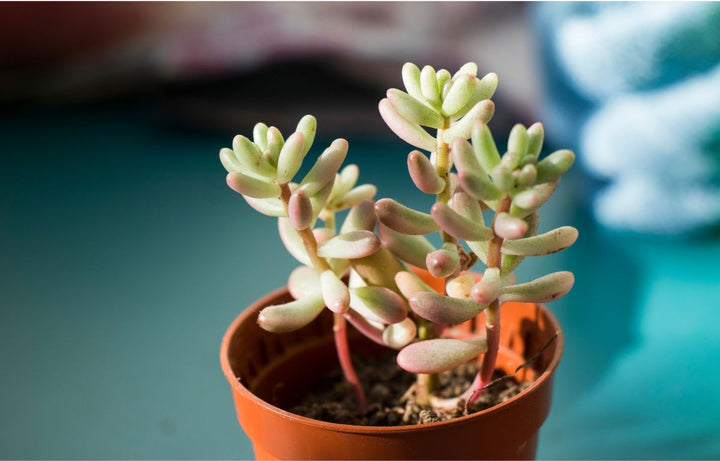
Plant Profile: Jelly Bean Sedum Pachyphyllum
Plant Profile: Jelly Bean Sedum Pachyphyllum
Sedum pachyphyllum, commonly known as Jelly Bean Sedum or the Money Plant, is a charming succulent that has captured the hearts of plant enthusiasts around the world. Its quirky appearance, easy maintenance, and adaptability make it an ideal choice for both beginner and experienced gardeners.

The Jelly Bean Sedum, native to Mexico, can be found growing in the arid regions of the country. It belongs to the Crassulaceae family and is closely related to other popular succulents such as Echeveria and Crassula. Its scientific name, Sedum pachyphyllum, derives from the Latin words "sedo" (to sit) and "pachy" (thick), referring to its plump, fleshy leaves.
Growing Conditions
To help your Jelly Bean Sedum thrive, it's essential to replicate its natural habitat as closely as possible. Here are the key growing conditions to keep in mind:
Sunlight: Jelly Bean Sedum loves bright, indirect sunlight. Place your plant near a south or west-facing window where it can receive plenty of light without being exposed to direct sunlight for extended periods.
Temperature: These succulents are well-suited to average room temperatures. Keep your Jelly Bean Sedum in a range of 18-24°C during the day and no lower than 10°C at night.
Soil: Well-draining soil is crucial for succulents. Use a cactus or succulent potting mix, or create your own by mixing regular potting soil with perlite or coarse sand to improve drainage.
Container: If you are a chronic overwaterer, choose a pot with drainage holes to prevent water from pooling at the bottom. Succulents store water in their stems and foliage and once they are at capacity, are unable to absorb or dispel the excess water at a fast enough rate leading to fungal and bacterial concerns like root rot.
Watering: Succulents like Jelly Bean Sedum prefer to dry out completely between waterings. This allows the stored water in their stems and leaves to evaporate allowing better absorption when they are watered. Water thoroughly when the top inch of soil feels dry, but avoid overwatering.
Humidity: Jelly Bean Sedum is well-suited to indoor conditions with humidity levels typically ranging from 30%-50%. Although unusually high for most succulent varieties, it conveniently aligns with the average humidity levels found in many homes.
Fertilisation: The Jelly Bean Sedum is a slow growing succulent so does not require large amounts of fertiliser. Fertilise sparingly during the growing season (spring and summer) with a diluted, balanced, liquid fertiliser. Reduce or stop fertilising in autumn and winter when the plant goes dormant.
Maintenance and Care
Maintaining a healthy Jelly Bean Sedum is relatively straightforward.
Pruning: Trim leggy or overgrown stems to encourage bushier growth. You can propagate the cuttings to grow new plants.
Air Circulation: Good air circulation helps prevent moisture from accumulating on the plant's leaves and in the soil causing fungal issues and increasing insect and pest infestation. Adequate air movement can help deter these problems by making it less hospitable for such issues to take hold.
Pests: Keep an eye out for common succulent pests like mealybugs and spider mites. If you notice any, treat the infestation promptly with neem oil or insecticidal soap.
Flowering: The small, star-shaped flowers typically appear in late winter to early spring and are usually yellow or yellow-green in colour. Some individuals may go years without flowering, especially when grown indoors.
Repotting: Repot your Jelly Bean Sedum every 2-3 years or when it outgrows its container. Spring is the best time for repotting.
Dormancy: Jelly Bean Sedum may go dormant in the winter, during which it requires less water. Reduce watering frequency but still monitor the soil's moisture level.

Problems and Solutions
Yellowing or Dropping Leaves: Yellowing or dropping leaves can be a sign of overwatering. Ensure that you allow the soil to dry out completely between waterings. Be more conservative with your watering schedule, especially in the winter when the plant goes dormant.
Crowded or Overgrown Pot: If your Jelly Bean Sedum has outgrown its pot or become overcrowded, consider repotting it into a slightly larger container. This will provide more space for the roots to grow and improve overall plant health.
Falling Over: Sometimes, Jelly Bean Sedum can become top-heavy and may fall over. To prevent this, you can provide support for the plant using stakes or gently tying it to a support structure. Additionally, pruning to maintain a more compact shape can help prevent toppling.
Sunburned Leaves: If your Jelly Bean Sedum's leaves become sunburned, move the plant to a location with less direct sunlight, especially during the hottest parts of the day. Gradually acclimate the plant to higher light levels if needed. Shrinking in size may be another indicator that the plant is receiving too much sunlight as it is trying to reduce its exposed surface area.
Jelly Bean Sedum, with its fascinating appearance and ease of care, makes a delightful addition to any succulent collection. By providing the right growing conditions and following the maintenance tips outlined, you can enjoy the beauty of this charming succulent while watching it thrive and grow. So, go ahead and bring a touch of Mexico's arid landscapes into your home with the wonderful Jelly Bean Sedum!
You can read more about succulent care in this blog.
